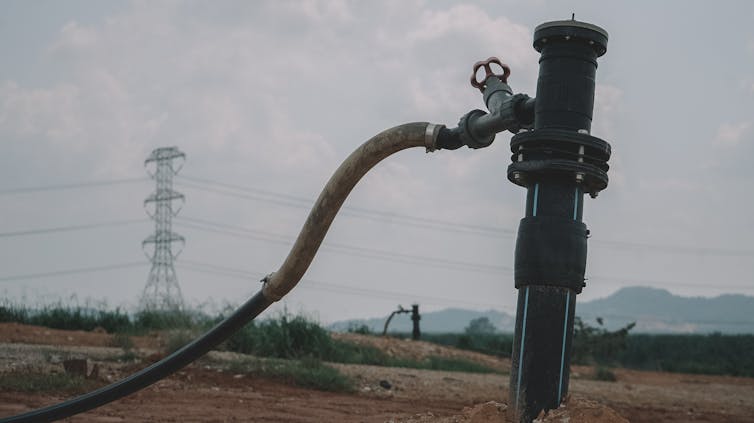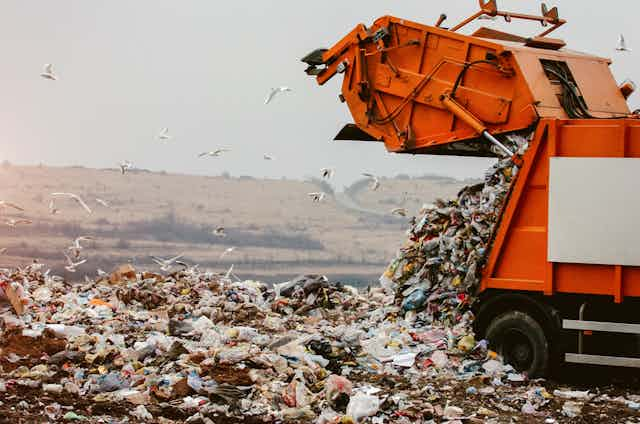England’s Environment Agency isn’t doing enough to protect the public from landfill gas, according to a recent high-court ruling. A judge said that five-year old Matthew Richards’ respiratory health problems were being made worse by fumes from nearby Walleys Quarry landfill site in Silverdale, Staffordshire. The judgement requires a particular landfill gas – hydrogen sulphide – to be reduced to one part per billion, less than an eighth of current levels in the area, by January 2022.
The ruling could mean that local authorities and government bodies tasked with maintaining environmental standards do more to support the rights of individuals when dealing with a community problem like air pollution.
So what about if you live within walking distance of a landfill site – should you be worried?
What you’re breathing in
Fumes from landfill sites tend to be a mixture of hundreds of different gases. These are formed by the decomposition of rotting food and other biological waste by bacteria; reactions between chemicals found in landfills, especially industrial wastes; and certain chemicals such as ammonia transforming from liquids and solids into vapour.
Methane is the biggest component of landfill gas – between 45% and 60% – followed by carbon dioxide (40%-60%). Trace amounts of other gases, such as benzene, toluene, ethyl benzene and xylenes, are toxic and can react to form ozone and other greenhouse gases. Landfill gas makes a significant contribution to man-made global warming. About 11% of the world’s methane emissions come from landfills – a powerful greenhouse gas which is between 28 and 34 times more effective at warming the atmosphere than carbon dioxide over short timescales.
Hydrogen sulphide – also known as sewer gas or swamp gas – is a colourless, flammable and potentially highly toxic gas known for its rotten-egg odour at low concentrations. The health consequences of exposure depend on how much a person breathes and for how long. Effects range from headaches or burning eyes to unconsciousness and death. Sulphides are mainly produced by bacteria breaking down human and animal waste in landfills. People can be exposed to these gases while at the site or even at home or work nearby, as Matthew Richards was. Gas odours can be detected more than a mile away from a landfill site.
Different gases have been linked to unpleasant health effects among populations living close to landfill sites and site workers, including low birth weights and birth defects, but no consistent pattern has been proven. Reports from those living close to landfills highlight regular headaches, fatigue, itchy eyes, sleeplessness and stress.
These gases form underground and slowly trickle to the surface where they can be carried by the wind. Landfill gases may even move through the soil and enter homes near the site, or accumulate in basements, car parks, drainage pipes and tunnels nearby. The most harmful gases tend to form in low-oxygen conditions.
Gas collection wells can limit how much gas migrates to prevent people from being exposed to it, and toxic compounds in landfill gas can be burned off or used in boilers or turbines to generate energy. These systems are complex and expensive to build, however, and wells cannot collect all the gas produced – managing between 65% and 85% of all gases on average.

Some landfill gases can occasionally form an explosive mixture when combined with the air in certain proportions and under low pressure. This happened at Loscoe, Derbyshire in 1986, which destroyed a house and badly injured three people. Landfill gas has also suffocated site workers in enclosed spaces.
What can be done about landfill gas?
More than 20 years ago, the Environment Agency was sufficiently worried about landfill gas that it funded a risk assessment model to identify hazards and factors that might cause harm. Studies into the health consequences of landfill gas have yielded conflicting results, and research is ongoing. But in the recent case, Mr Justice Fordham ruled that Public Health England’s advice that “risk cannot completely be excluded if exposure remains at current levels” meant the Environment Agency must act to reduce gas concentrations.
We know that landfills are bad for the environment because they are a major source of pollution. The waste hierarchy, which ranks the desirability of options for managing waste, places landfills at the very bottom.
I have argued for two decades that we should substantially limit the amount of waste we bury, and prevent waste where possible and encourage reuse. The right infrastructure to repair and recycle waste, and efficient collection services, are needed for the public to be able to manage their own waste more sustainably.
Compared to Germany, where there are only about 160 landfill sites, politicians in England have failed dismally to provide the right leadership and waste policies to transition from landfill towards a circular economy, where waste is transformed from an inconvenience into a useful resource. There are currently more than 570 landfill sites in England and waste disposed via landfill actually increased by 4% in 2019.
For the protection of public health and the environment, it’s time to bury landfills forever.

